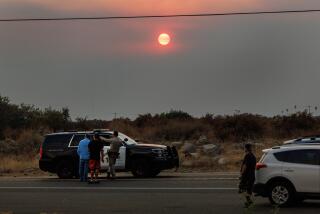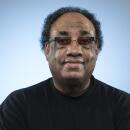1 of 3 Air Pollution ‘Hot Spots’ in Area : Cancer-Smog Report Troubles, Baffles Burbank
The woman on the phone to Burbank Councilwoman Mary E. Kelsey was in tears. She was afraid that her children were going to die because the air was bad in Burbank.
A group of parents surrounded Burbank Councilman Michael R. Hastings as he delivered his 7-year-old daughter to school. Is the air quality in Burbank as dangerous as they’d heard? What is the city going to do about it? they asked.
Those concerns were just part of the reaction throughout Burbank last week to a South Coast Air Quality Management District report that named the Burbank area as a “hot spot” for toxic air contaminants that could cause cancer.
The report by the Los Angeles region’s air pollution control agency said that the Burbank area, which includes Glendale, North Hollywood and Van Nuys, is one of three areas in the region that showed “significantly higher” concentrations of toxic air contaminants.
Those concentrations pose cancer risks that, while still low, are twice as high as other regions in Los Angeles, the report said. The other “hot spot” areas are Rancho Dominguez and Hawthorne.
While residents of those areas should not pack up and leave, AQMD officials said, they do have cause for concern.
The increased risks mean that the amount of contaminants could cause cancer in 100 of 100,000 people, AQMD officials said, based on the assumption that a person would be exposed to those concentrations during a 70-year lifetime.
“When you consider that 25,000 out of 100,000 people will get cancer anyway, there is an additional risk, but it’s slight,” AQMD spokesman Tom Eichhorn said.
Some Burbank officials responded to the study by saying, in effect, “Why always Burbank?” Others joked about the report, feigning coughing spells during conversations. Still others said the report needs to be taken seriously.
“Some people are saying, ‘How come they’re picking on Burbank?’ but I don’t want it buried,” Hastings said. “We need to move forward and be a model city for cleaning up our air. If we don’t, I’ll be the first person to tell folks to leave town--and I’ll be at the front of the line.”
But Burbank officials conceded that they are in no position to clean the air or enforce additional air quality regulations at this point.
“Most of the regulations to control contaminants are already in place, and we would make sure that any new business with those kinds of contaminants in their emissions would keep them at an allowable level,” said Carl Brooks, Burbank’s public works director. “The AQMD is developing programs that will more directly deal with controlling the contaminants, so we are waiting to see what they will do.”
The report marked the first time that AQMD has attempted to determine areas within the Los Angeles Basin where multiple toxic air contaminants pose the highest risks of cancer.
The AQMD named the vicinity “the Burbank area” because the monitoring instruments were atop the Burbank police station.
The dominant contaminants in Burbank’s air are benzine, a mixture of hydrocarbons found in gasoline, and hexavalent chromium, which is used to treat chromium plating.
Burbank and Glendale are near the Glendale, Hollywood, Ventura and Golden State freeways. Several metal plating plants are in Burbank.
“For that area, the amount of benzine is definitely high because there’s a lot of congestion on those freeways,” said Wayne Barcikowski, an AQMD air quality specialist. “The wind from the ocean blows these contaminants around.”
The study said the AQMD would use the air quality data to study what ingredient and emission controls should be instituted. The agency will then issue priorities for such controls and send those to local jurisdictions, officials said.
The more immediate problem for Burbank is how residents and outsiders view the report.
“It is negative news for this city,” said Stuart Orbach, chief executive officer of the Burbank Chamber of Commerce. “I’m not sure how we got this honor when there are so many other cities who get the same air. We’re not pleased by the stigma it gives Burbank, and we’re trying to get a handle on what this all means by studying it ourselves.”
Orbach said he did not know yet whether the city’s air quality would discourage businesses from locating in Burbank.
Mayor Al F. Dossin said he didn’t think the report would have much impact. “I don’t think people will think this changes the character of the city,” Dossin said. “People know what Burbank is all about.”
Councilwoman Kelsey agreed.
“These are problems that are not uncommon in the Southern California area,” she said. “There are a lot of cars here, and you’re going to find that kind of air. We would like to find some way to clean it up, but we don’t know how to do it.”
More to Read
Sign up for Essential California
The most important California stories and recommendations in your inbox every morning.
You may occasionally receive promotional content from the Los Angeles Times.











